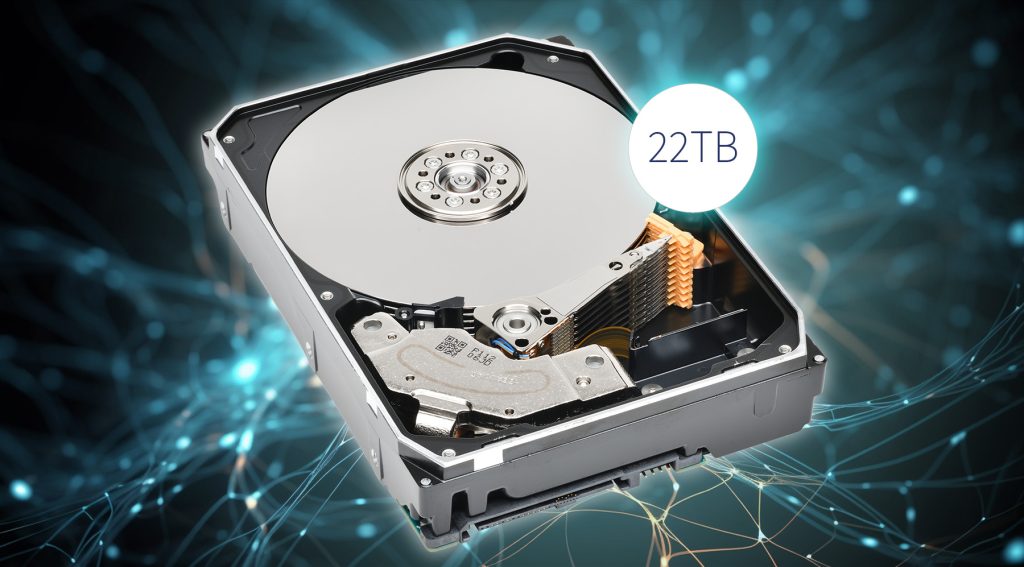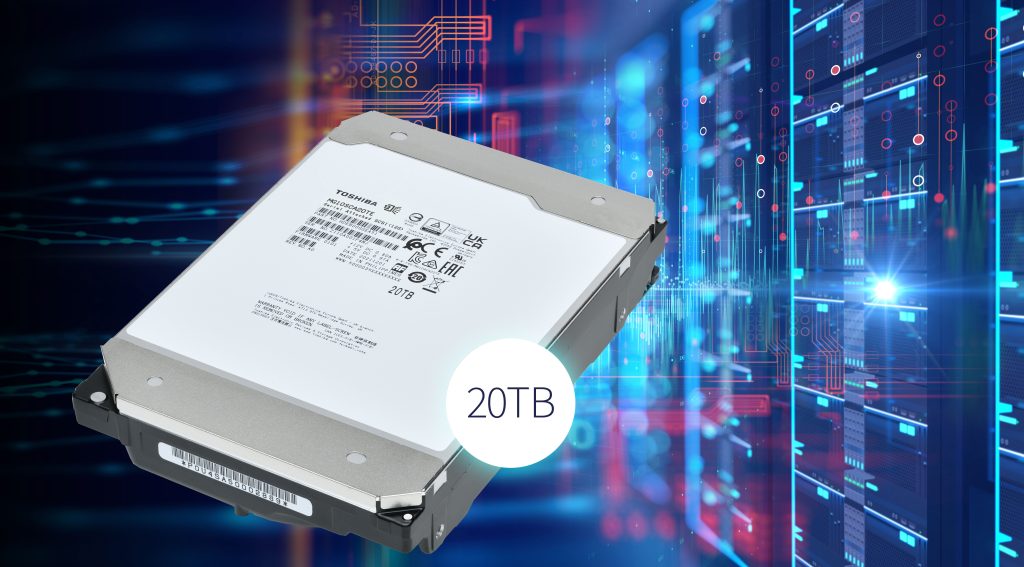12.09.2023
Toshiba anuncia la serie de discos duros MG10F de 22TB

Toshiba Electronics Europe GmbH anuncia la nueva serie de discos duros MG10F con capacidad de 22TB[1] y tecnología de grabación magnética convencional (CMR) apoyada en el diseño de 10 platos de helio sellado de la compañía.
Como elemento clave en la infraestructura de almacenamiento y en la nube, el MG10F de 22 TB ofrece un 10% más de capacidad que el modelo de 20 TB de la generación anterior de Toshiba. Diseñados y fabricados para satisfacer las crecientes necesidades de almacenamiento de datos de sus grandes clientes, los discos duros MG10F de 22 TB son compatibles con una amplia gama de aplicaciones y cargas de trabajo, en casos de uso tanto de escala cloud como de centros de datos tradicionales. La mayor capacidad del MG10F de 22 TB permite aumentar la densidad de almacenamiento de las instalaciones a escala nube con un menor coste total de propiedad.
Los HDD de la serie MG10F ofrecen un rendimiento de 7.200 rpm, una ratio de carga de trabajo anual de 550TB[2] y opción de interfaces SAS y SATA, todo ello en el formato estándar de 3,5 pulgadas[3], con helio sellado y eficiente energéticamente.
Está previsto que los envíos de unidades de prueba de los HDD de la serie MG10F de 22TB comiencen en el tercer trimestre de este año para la interfaz SAS y en el cuarto trimestre también de 2023 para la interfaz SATA.
Más información sobre los nuevos productos.
[1] Definición de capacidad: un terabyte (TB) = un billón de bytes, pero la capacidad de almacenamiento realmente disponible puede variar según el entorno operativo y el formato. La capacidad de almacenamiento disponible (incluidos ejemplos de varios archivos multimedia) variará según el tamaño del archivo, el formato, la configuración, el software y el sistema operativo y/o las aplicaciones de software preinstaladas o el contenido multimedia. La capacidad formateada real puede variar.
[2] La carga de trabajo es una medida de la transferencia de datos en el periodo de un año y se define como la cantidad de datos escritos, leídos o verificados por comandos del sistema host.
[3] “3,5 pulgadas” es el factor de forma de los discos duros. No indica el tamaño físico de una unidad.
* La información en este documento, incluidos precios y especificaciones de producto, contenido de servicios e Información de contacto, está actualizada y se cree exacta a la fecha del anuncio, pero puede estar sujeta a cambios sin notificación previa.
* Los nombres de empresas, productos y servicios mencionados aquí pueden ser marcas comerciales de sus respectivas compañías.
16.08.2023
HDDs have a long life ahead in certain workloads
A Podcast by Antony Adshead, Rainer Kaese from Toshiba Electronics Europe
Listen to the podcast here: https://cdn.ttgtmedia.com/rms/editorial/podcastToshibaJuly23.mp3
Spinning disk hard drives are far from dead, and with data volumes set to explode, there are use cases that suit them well. That’s the view of Rainer Kaese of Toshiba in this podcast.
Some have predicted the imminent demise of spinning disk hard drives (HDDs), but Rainer Kaese, senior manager for business development in storage products at Toshiba Electronics Europe, argues they have many more years life left in them.
Core to his argument is that with the volume of data expanding rapidly, HDDs offer cost-effective storage that can cope with huge capacity needs and the right performance for particular workloads if their capabilities are harnessed correctly.
Antony Adshead: How long should we expect spinning disk HDDs to be around for in the enterprise, and why?
Rainer Kaese: That’s a really good question and there’s a clear answer: for many more years. So, at least five, if not 10, or even more years.
And there’s a quite simple reason: the data we have to store in enterprise and cloud is exploding. It’s growing exponentially and it has to be stored in a competitive way. People don’t want to pay all their money for it. And spinning disks are and will be the most economical way to store all these zettabytes of data.
If we compare it with SSDs [solid-state drives], the bit cost, the capacity cost of hard disk drives is currently around 1/7th. It used to be 1/10th. Now it is 1/7th, but if you look at the cost curve of the price per capacity of HDD and SSD they are dropping as parallel lines. And we know that parallel lines never meet.
So, hard disk drives are, and will always be, much cheaper in terms of cost per capacity than SSDs.
Adshead: What workloads will be most appropriate for HDDs in the coming five to 10 years? Here, we’re assuming flash will increase its share at the higher levels of performance.
Kaese: If it is about performance, if it is about throughput, agility, IOPS and things, then flash will lead.
However, there are all this petabytes and zettabytes of bulk data, and it’s not just what we know today. There will be more data coming out of this internet of things, Industry 4.0 – so much more data will be created and this data needs to be saved, stored and will also need to be analysed; that’s why we store this data.
And if you look at the storage landscape for that application where you are storing and analysing a lot of data, then on one hand, we can say that flash will be much more expensive. On the other hand, there is also tape. Tape is a lot cheaper than flash and tape is a lot cheaper than HDDs, but tape is not an online medium. So, for online storage […] and especially online analytics, tape cannot be used.
In this middle field of active online data, of massive amounts, that will be the playground for hard disk drives.
Adshead: How can spinning disk HDD compete against its solid-state rivals?
Kaese: If we talk about performance, we have to see that the HDD is way slower than any SSD. So, a single NVMe component is 5x to 20x compared to hard disk drives.
However, the HDD’s domain is large online storage, [and so] we don’t compare single components any more. Large online storage means a lot of hard disk drives. A lot of small HDDs can join their rather slow performance to one big, agile storage, and the industry has implemented many ways [to make] hard disk drives a little more agile. And this … leads to large online storage.
All these videos, this online data, it is instantly there, but it is coming from hard disk drives not from NVMe, and this is because HDDs have joined forces with many [of them to be] able to deliver the performance required.
09.05.2023
Toshiba logra la calificación de garantía de interoperabilidad de Microchip Adaptec® para sus discos empresariales insignia basados en SAS

Madrid, 9 mayo 2023 – Toshiba Electronics Europe GmbH ha obtenido la calificación de garantía de interoperabilidad con las series de adaptadores de almacenamiento Microchip Adaptec® SmartRAID 31xx y 32xx para las versiones SAS de 12 GB/s de sus HDD de tipo empresarial MG10SCA20TE y MG10SCA20TA. Con ello, estas unidades de disco duro se han incorporado a la lista de compatibilidad de Microchip para referencia de sus clientes.
La certificación, conseguida una vez superadas las nuevas pruebas de compatibilidad realizadas por Microchip, demuestra la compatibilidad completa de los modelos de la serie MG10 de HDD de alta capacidad citados con los controladores RAID (matriz redundante de discos independien-tes, por sus siglas en inglés) y con los adaptadores de bus de host (HBA) de Microchip Adaptec®.
El avance, que confirma la versatilidad de aplicaciones de las unidades de disco duro de Toshiba, se produce tras la obtención de la calificación de interoperabilidad con Adaptec SmartRAID 31xx/32xx del modelo MG10ACA de HDD SATA 6GB/s a finales de 2022.
Los discos duros MG10SCA20TE/A de Toshiba, con altas capacidades de almacenamiento de da-tos e interfaz SAS 12 GB/s, se suministran en factores de forma compactos de 3,5 pulgadas. Cada unidad cuenta con 10 discos en un diseño lleno de helio y ofrece una velocidad de rotación de 7200 rpm.
Según Rainer W. Kaese, director senior de Desarrollo de Negocio de la división de Productos de Almacenamiento de Toshiba Electronics Europe GmbH, “al tener asegurada la interoperabilidad de los productos de Microchip y Toshiba gracias a las pruebas exhaustivas llevadas a cabo por Micro-chip, conseguimos que la implementación del almacenamiento de datos sea más sencilla para nues-tra base de clientes”. “Esta certificación significa”, -explica Kaese–, “que los discos duros, junto con HBA y los controladores de almacenamiento que los acompañan pueden utilizarse con total con-fianza en su combinación de rendimiento operativo y fiabilidad a largo plazo”.

